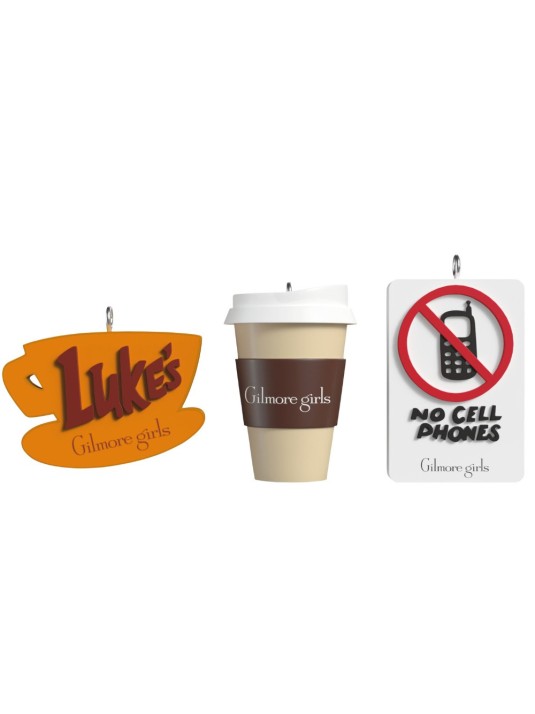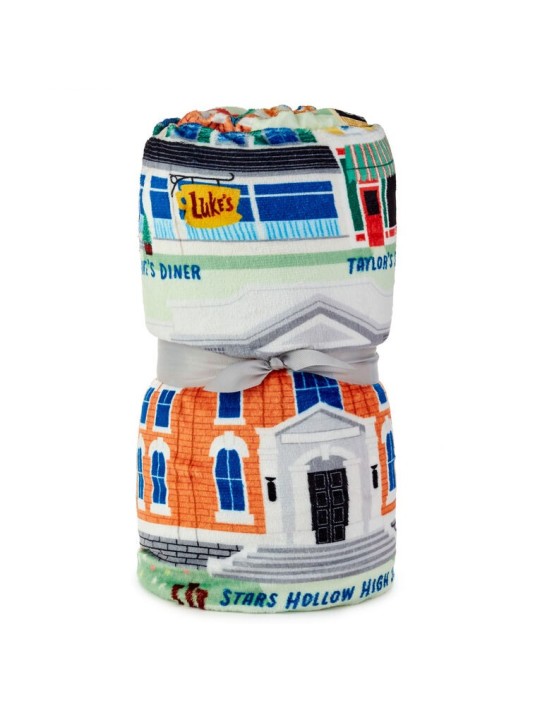Gilmore Girls Memorable Moments Oversized Throw Blanket, 80x60 PCL1083
Gilmore Girls Mini Ornament, Set of 3 5QXM9505
Take a trip to Stars Hollow and channel your inner Lorelai or Rory when you hang these fun Christmas tree ornaments. The set of three mini "Gilmore Girls" icons includes a latte mug with the Luke's Diner logo, a Gilmore Girls travel coffee cup and a "No Cell Phones" sign. Perfect for a themed tabletop tree and makes a great gift for fans of the popular television series.
Artist: Jaye Wiley
Gilmore Girls Set of 4 2.8cm Magnetic Page-Top Bookmarks 12204GG
- While a regular bookmark might stay put in a large, dense novel, they often slide out of a well read book, spiral notebook or journal
- Problem solved with this set of four magnetic page-top bookmarks featuring officially licensed, iconic pop-culture graphics!
- Full color bookmarks are constructed of fully laminated paperboard with magnets enclosed within the paperboard making them sturdy, attractive and lightweight
- The front of each bookmark measures approximately 2.8cm high and wide and closes securely over the top of your pages where they stay put without protruding from the top of your book
- The perfect gift for your favorite reader or writer and a must-have for back to school
Gilmore Girls Stars Hollow Appetizer Plates, Set of 4 1PCL1065
Gilmore Girls Stars Hollow Icons Collectible Drinking Glass, 13.5 oz. WOW1031
Gilmore Girls Stars Hollow Map 1,000-Piece Jigsaw Puzzle, PCL1015
Keep your friends talking fast and your coffee close as you put together this fun Gilmore Girls jigsaw puzzle featuring a pictoral map of Stars Hollow. Fans will love putting together this 1,000-piece jigsaw puzzle featuring the quaint town complete with Luke's Diner, the Dragonfly Inn, Lorelai's house, the town square and more. This puzzle makes a great stay-at-home activity for individuals and families alike—especially when streaming your favorite episodes of Gilmore Girls as you puzzle.
- Gilmore Girls jigsaw puzzle with map illustrations includes 1,000 interlocking pieces in a unique storage box.
- Ages 9+. Small parts. Not intended for children under 3 years.
- Finished size: 24" W x 30" H
- Pkg.: 4.88" W x 10.13" H x 4.88" D
Gilmore Girls Stars Hollow Map Blanket, 50x60 PCL1014
Snuggle up with Gilmore Girls on TV and this Stars Hollow blanket curled around you. Comfy, cozy fleece throw features a colorful pictoral map of the scenic town complete with Luke's Diner, the Dragonfly Inn, Sookie's house and more. This Gilmore Girls blanket makes a great gift idea for family members and friends who are fellow fans of the iconic, fast-talking show.
- Gilmore Girls fleece blanket features a map of Stars Hollow complete with the Dragonfly Inn, Luke's Diner, the town gazebo and more.
- 100% polyester.
- Machine wash cold; do not bleach. Tumble dry low. Do not iron. Do not dry clean.
- 50" W x 60" H
Gilmore Girls Stars Hollow Sign Hallmark Ornament HCM4298
Material: Resin
Count: One Hallmark Christmas tree ornament.
Gilmore Girls Stars Hollow Town Festivals Canvas Tote Bag PCL1090
Dimensions: 12.75'' W x 13.75'' H x 4.75'' D
Material: Fabric









